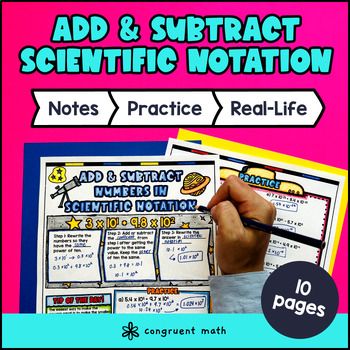Want more ideas and freebies?
Get my free resource library with digital & print activities—plus tips over email.
Join for free resources →
$4.25
Ever wondered how to teach adding and subtracting numbers in scientific notation in an engaging way to your eighth-grade students?
In this lesson plan, students will learn about scientific notations and their real-life applications. Through artistic, interactive guided notes, check for understanding, a doodle & color by number activity, and a maze worksheet, students will gain a comprehensive understanding of adding and subtracting numbers in scientific notation.
The lesson culminates with a real-life example that explores how adding and subtracting numbers in scientific notation is used in practical situations.

$4.25
After this lesson, students will be able to:
Before this lesson, students should be familiar with:
As a hook, ask students why adding and subtracting numbers in scientific notation is important in real-life applications. Refer to the last page of the guided notes as well as the FAQs below for ideas.
Use the first page of the guided notes to introduce adding and subtracting numbers expressed in scientific notation. Walk through the key points of the topic, including how to add and subtract the numbers and how to rewrite the numbers in scientific notation form. Refer to the FAQ below for a walk through on this, as well as ideas on how to respond to common student questions.
Based on student responses, reteach concepts that students need extra help with. If your class has a wide range of proficiency levels, you can pull out students for reteaching, and have more advanced students begin work on the practice exercises.
Have students practice adding and subtracting numbers in scientific notation using the practice worksheet on the second page of guided notes. Walk around to answer student questions.
Fast finishers can dive into the maze activity (page 3 of guided notes) and color by number (page 4 of guided notes) for extra practice. You can assign it as homework for the remainder of the class.
Bring the class back together, and introduce the concept of real-life uses of adding and subtracting numbers in scientific notation. Use the last page of the guided notes for students to read a detailed example of adding and subtracting numbers in scientific notation form. Explain that scientific notation is commonly used in various fields of science, such as astronomy, physics, and chemistry, where extremely large or small numbers are encountered.
To illustrate the real-life application, provide the students with examples of situations where scientific notation is used generally. Some examples could include:
Ask the students to brainstorm other examples they can think of where scientific notation is useful in real life. Encourage discussion and allow them to share their ideas with the class.
Refer to the FAQ section for more ideas on how to incorporate real-life applications into this lesson.
If you’re looking for digital practice for adding and subtracting numbers in scientific notation, try my Pixel Art activities in Google Sheets. Every answer is automatically checked, and correct answers unlock parts of a mystery picture. It’s incredibly fun, and a powerful tool for differentiation.
Here are some activities to explore:
A fun, no-prep way to practice adding and subtracting numbers in scientific notation is Doodle Math — they’re a fresh take on color by number or color by code. It includes multiple levels levels of practice, perfect for a review day or sub plan.
Here are some activities to try:
Scientific notation is a way to express numbers that are very large or very small. It is written as a number between 1 and 10 multiplied by a power of 10. For example, 3.4 x 10^5 represents the number 340,000.
To add numbers in scientific notation, you need to make sure the exponents of the powers of 10 are the same. Then, you can simply add or subtract the coefficients. Finally, adjust the coefficient to make it between 1 and 10 if necessary.
Subtracting numbers in scientific notation follows the same steps as adding them. Make sure the exponents of the powers of 10 are the same, subtract the coefficients, and adjust the coefficient to be between 1 and 10 if needed.
Scientific notation is used to represent very large or very small numbers in a concise way. It makes it easier to perform calculations and work with these numbers, especially in scientific and mathematical fields.
To convert a number to scientific notation, first identify the coefficient, which is a number between 1 and 10. Then, count the number of decimal places you need to move the decimal point to get the original number. If you move the decimal point to the left, the exponent of the power of 10 will be positive. If you move it to the right, the exponent will be negative.
Scientific notation is commonly used in scientific research, engineering, and astronomy. It helps represent distances between planets, the sizes of atoms and molecules, and the masses of celestial objects. It is also used to express very large or small quantities in fields such as biology, chemistry, and physics.
Scientific notation uses powers of 10 to represent very large or small numbers. The exponent in scientific notation tells us how many times we need to multiply or divide the coefficient by 10 to get the original number.
You can find additional practice activities (print and digital) for adding and subtracting numbers in scientific notation here. You may also consider using worksheets and activities specifically designed for practicing this skill.
Get my free resource library with digital & print activities—plus tips over email.
Join for free resources →